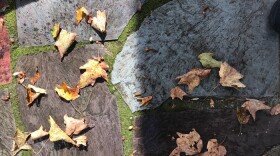With the exception of a few stragglers, hummingbirds have departed the Hudson Valley for their winter homes in southern Mexico and Central America. Most of those that remain can be spotted at an exhibition called “Cross Pollination; Heade, Cole, Church and Our Contemporary Moment.” It’s at the Thomas Cole National Historical Site in Catskill, NY and just across the Hudson River at the Olana State Historic Site. But you better hurry. It only runs until the end of the month before migrating south along with the birds to the Crystal Bridges Museum of American Art in Bentonville, Arkansas.
Retiring one’s hummingbird feeders for the season is a bittersweet experience, the reluctant admission that summer is finally over and autumn and then winter on their way. Melancholy can be appeased by hanging seed feeders for year-round avian residents such as chickadees, titmice and cardinals. However, as personable as these species are, few creatures better embody the miracle of creation than a jewel-like ruby-throated, hovering in midair, its wings beating over fifty times a second. Fun fact: the feat requires so much energy that if hummingbirds were the size of humans they’d consume 155,000 calories a day.
Here’s another one, courtesy of Jon Dunn, author of The Glitter in the Green: In Search of Hummingbirds: the courtship ritual of the reddish-pink and green male Anna’s Hummingbird, native to the western coastal reaches of North America, involves impressing his potential mate by dive-bombing her from a height of a hundred feet, then applying the breaks at the last minute and fanning his tail while emitting a loud chirp. The speed of the dive – reaching 385 body lengths per second – is “the highest known length-specific velocity attained by any vertebrate,” Dunn writes.
Thanks to Christopher Benfey, the Mellon Professor of English at Mount Holyoke College, who shared this information in an August New York Review of Books discussion of hummingbird-related books and the “Cross Pollination” show at the Thomas Cole House and Olana. I got around to reading it just in time to score a ticket to the exhibition before it closes on October 31st.
Hudson River School painter and hummingbird obsessive Martin Johnson Heade’s eight small hummingbird paintings, collectively known as The Gems of Brazil, and based on his visit to their South American habitat in 1863, form the core of the show. But as beautiful as these misty high mountain and rainforest compositions are, each one a landscape painting in its own right, they fail to convey the full charm of these tiny creatures for one simple and obvious reason. They don’t capture the hummingbirds in flight. When you think about it, visualizing their mechanics would have been nearly impossible before photography and stop-action techniques. And a flightless hummingbird is little more than an ornament. The character of the creature reveals itself in movement.
Cross Pollination, the title of the show, is also a pun. It documents how the work of Thomas Cole, his student Frederick Church, and Heade who shared a studio with Church on 10th street in New York City, inspired each other. As well as Cole and Church’s daughters, Emily Cole and Isabel Charlotte Church, both observant botanical painters and also represented in the show.
But what contributes much of the energy is the work of contemporary artists that mingle with those of the American Old Masters. Paula Hayes terrariums. A worldly and otherworldly pink forest diorama by Patrick Jacobs. And Juan Fontanive’s 2018 Ornithology. It’s a work Martin Johnson Heade might have composed if he’d had access to modern technology. Motorized images of hummingbirds simulate their nectar sipping acrobatics.
However, if you’re a denizen of the Hudson Valley or just a casual visitor, what you might find most moving and recognizable as well as ironic is a six-minute multi-screen presentation in a spacious parlor on the second floor of the main house. The subject is Thomas Cole’s life and work, the artist’s own words providing the narration. It’s an ode to the local landscape and his excitement at being able to portray it on canvas and make a reputation for himself.
“All nature here is new to art,” Cole writes. “The mists were resting in the valley of the Hudson – the tops of mountains were visible on the other side – you might imagine them in another world. The fields in shadow were a most beautiful fresh green, the mountainside was brilliant yet dark.”
Yet even back in the mid 1800’s Cole was bemoaning the way nature was being destroyed in the name of progress, divinity indiscriminately felled by the ax. “Yet I cannot but express my sorrow that the beauty of such landscapes is quickly passing away,” he wrote. “The copper-hearted barbarians are cutting all the trees down in the beautiful valley on which I have looked so often with a loving eye. This throws quite a gloom over me. The ravages of the axe are daily increasing.”
I found his observations both familiar and oddly hopeful. Nature and progress, it turns out, can coexist. The forests were felled but reborn. Perhaps we’ll save them again, and them us.
Ralph Gardner, Jr. is a journalist who divides his time between New York City and Columbia County. More of his work can be found at ralphgardner.com
The views expressed by commentators are solely those of the authors. They do not necessarily reflect the views of this station or its management.





